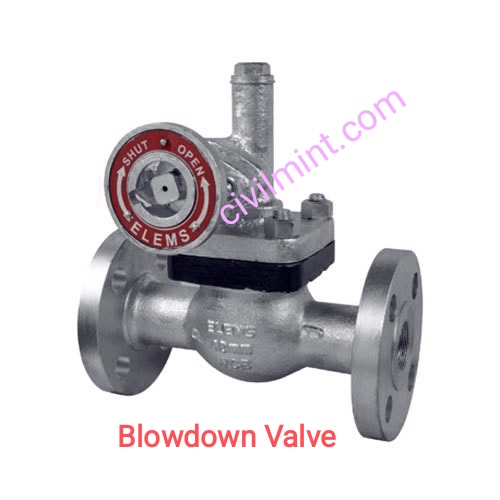Table of Contents
What is Blowdown Valve?
Blowdown valve in process engineering plants are a special type of pipeline valve with a wide range of applications. The main purpose of a blowdown valve in a plumbing or piping system is to initiate bleed when the valve is actuated.

Drainage valves depressurize systems or equipment for maintenance or emergencies, usually by directing unwanted liquids into the flare. A blow-off valve is basically an emergency on-off valve that is actuated by a signal from an emergency shut-off system.
How Does Blowdown Valve Work?
Blowdown valve can maintain continuous liquid flow under high differential pressure while maintaining liquid tightness. Blow off valves can be used to drain large amounts of liquid from any device. The required bleed rate is determined by considering various parameters. Example:
- Unit pressure
- Drain line size
- Drain line length, etc.
Usually two drain valves are used in series. One of these acts as a sealing valve and the other as a relief valve. The isolation valve opens at the beginning of the process and closes at the end. Both the seal and relief valves are fully open and act rapidly to prevent erosion of the disc face and seat.
Be careful not to allow water scale or rust particles to enter. This is accomplished by opening the particle flushing valve when it resists closing. In boiler operation, the lower blow valve is usually replaced as part of maintenance.
Blow rate for boiler operation is:
Blow rate = (drain water amount / feed water amount) x 100
Types of Blowdown Valves
There are two types of bleed valves, depending on the principle of operation:
- Continuous Blowdown Valve
- Intermittent Blowdown Valve
(a) Continuous Blowdown Valve
For boiler operation, the blowdown valve maintains his TDS level in the boiler drum through continuous operation.
Continuous bleed valves typically consist of an angle valve with a needle-like trim on the venturi diffuser to provide sufficient surface area for high velocity fluids to avoid clogging.
(b) Intermittent Blowdown Valve
As the name suggests, this type of relief valve operates at set intervals to dispense fluid. Intermittent drain valve ensures a reliable shutoff even after repeated drains.
Performs both blow-off and sealing operations with a multi-stage draw cone. It blows down in the open position while sealing in the closed position. Intermittent relief valves have different throttling and sealing areas to reduce erosion and ensure long-lasting tightness.
Blowdown Valve Materials
I have listed some common materials which is used in the manufacturing process of blowdown valve.
- Carbon Steel
- Brass
- Copper
- Bronze
- Cast iron
- Aluminum
- Stainless steel
- Monel
- Nickel
- Zirconium, etc.
Benefits of Blowdown Valve
- Increased productivity.
- personnel savings.
- Safer and more efficient.
- Persistence of solid contaminants at a limited rate.
- Reduction of corrosion due to removal of contaminants.
- Prevention of deposits on the inner surface of equipment and boiler tubes.
- Simple design for easy maintenance.
- Multiple uses including boiler service.
- Reduced maintenance time.
- Manual or automatic operation.
- No special tools required.
Some Key Limitations
- Loss of energy when hot water flows out of the water drum.
- Large pressure loss when valve is open.
- Boiler fuel consumption increases as boiler blowdown increases. Manual operation of the
- blowdown valve requires additional working hours.
Utilization of Blowdown Valve
- Containers and equipment to prevent contribution to explosion or fire hazards.
- compressor system for releasing trapped pressure during shutdown.
- industrial boilers, heat exchangers and cooling towers control the level of dissolved and suspended solids in water.
- In a tube for removing unwanted material.
